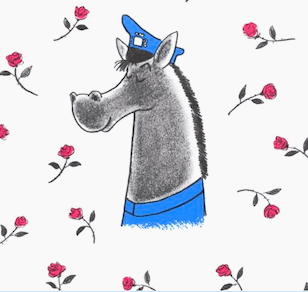from Bloodhorse.com “I’ll Have Another’s Treatment ‘Routine Care’
By Ron Mitchell and Eric Mitchell

Three veterinarians who reviewed the treatment regiment of I’ll Have Another between the Preakness Stakes and the Belmont Stakes found nothing out of the ordinary and took exception to characterizations in a July 11 New York Times article that indicated the colt had been given powerful drugs to cover up unsoundness.
The winner of the Kentucky Derby Presented by Yum! Brands and the Preakness was scratched from the June 9 Belmont due to tendonitis that was discovered the day before the race. He was subsequently retired and sold to a Japanese farm for stud duty.
A review of I’ll Have Another’s veterinary records, which trainer Doug O’Neill was required to turn over to the New York State Racing and Wagering Board, showed treatments that are consistent and standard with most racehorses, according to three licensed veterinarians.
Download the I’ll Have Another Vet Records.
“There is nothing here that was done that wasn’t on the up-and-up,” said John Kimmel, a New York-based trainer and licensed veterinarian, after reviewing the records obtained from the New York State Racing and Wagering Board.
“All of these treatments are perfectly normal routine care,” said Kentucky-based racetrack veterinarian Dr. Foster Northrop. “All of these medications are used frequently and all are peer-approved treatments.”
“What was done with him is actually less than is done with some horses,” said Dr. Mark Cheney, a longtime racetrack veterinarian based in Lexington.
The same records reviewed by Kimmel, Northrop, and Cheney were the subject of a front page article in the Times headlined “Records Show Triple Crown Contender Had History of Ailments.” The article noted that two days before the Belmont Stakes “the colt was injected with two powerful painkillers as well as a synthetic joint fluid.”
“The use of pain medication and anti-inflammatory drugs is neither illegal nor uncommon in racing. But the fact that drugs were being used on I’ll Have Another in the days before a race of immense national interest, and were being ordered by a trainer with a controversial past underscores the uneasiness the issue of drugs is creating in American racing,” the article said.
According to the treatment records maintained by attending veterinarian Dr. James Hunt, on May 23 the colt was diagnosed with osteoarthritis and four days later was treated with the medication Polyglycan for the condition.
From May 23 until after the Belmont, I’ll Have Another was regularly given electrolytes and vitamins, as well as medications that are commonly used on a regular basis in race horses. They included albuterol, which is given to open constricted bronchial airways; acepromazine, for sedation; xylazine, for sedation prior to a radiographic exam; and omeprazole, given to prevent gastric ulcers.
Two days before the Belmont, the deadline for when pre-race medications can be given, I’ll Have Another was administered the painkiller phenylbutazone, the anti-inflammatory drug dexamethazone, and polyglycan, an intravenous medication routinely administered to lubricate joint cartilage and prevent arthritis.
Kimmel said referring to phenylbutazone as a “powerful painkiller” is a misnomer and that the other medications were appropriate treatments for the diagnoses. Cheney said dexamethasone does reduce inflammation but is not a painkiller. Regarding the polyglycan, Kimmel said the medication is comparable to people taking glucosamine for aching knees.
“Polyglycan is probably the kindest kind of medication you could give and could actually help prevent arthritis,” Kimmel said. “The Bute was given two days before the race. It is most effective in the first 24 hours and would have had a negligible effect on race day.
“After a hard race, a horse could have had some joint changes and some inflammation, and with a valuable horse heading into a valuable race, these treatments were appropriate. Nothing is out of line here for a horse of his caliber,” Kimmel concluded. Regarding osteoarthritis, Kimmel said most horses have some varying degree of inflammation and wear and tear on their joints even as yearlings.
“It has nothing to do with the soundness or suitability of the joints,” Kimmel said. “And yet, (the New York Times) is creating the illusion that this horse was so bad he wasn’t in a condition to race, but that doesn’t appear to be the case. I watched this horse train at Belmont, and he put in some strong gallops. The Times is just taking pot-shots.”
In being granted a license in New York, O’Neill agreed to a stiff set of conditions because of pending disciplinary action in California stemming from an excessive level of carbon dioxide in one of his horses in a post-race test in 2010. Next month, he will begin to serve a 45-day suspension stemming from that case.
Included in the conditions of O’Neill’s New York license was the following stipulation: “Access will be provided to any and all veterinary records of treatment and veterinary records; further, I will obtain records of treatment on an ongoing basis from the treating veterinarian and file these records no later than 9:30 a.m. the day following treatment with the board steward or his designee.”
Because the same requirements did not apply to the other Belmont entrants, the same kind of veterinary treatment records obtained for I’ll Have Another are not available for the 11 horses that ran in the classic, so it is unknown what treatments they underwent leading up to the race.
As per a directive from the NYSRWB, all Belmont entrants were required to be housed in one barn together, with no other horses, beginning at noon June 6, through the end of the Belmont. The Belmont Stakes barn had stiff security measures in place and every individual and item taken into the barn was documented.
Noting the differences between his assessment of the I’ll Have Another’s treatment record and those of two veterinarians quoted in the Times, Northrop concluded, “The New York Times went out on a big limb as far as I’m concerned.”
Efforts to reach Hunt for comment were unsuccessful.
 Who hates a horse? New York Times “journalist” Joe Drape hates this horse. He led a pitiful camapign against this cute-as-a-button chestnut colt, who cost a mere $30,000 and ran like an insane lunatic.
Who hates a horse? New York Times “journalist” Joe Drape hates this horse. He led a pitiful camapign against this cute-as-a-button chestnut colt, who cost a mere $30,000 and ran like an insane lunatic.
If you hate Joe Drape, tell Arthur Brisbane, the NYT’s public editor, who “represents our readers”. You can reach him by email, public@nytimes.com, or by calling (212) 556‑7652. Do it because “Cookies” can’t talk, only whinny.